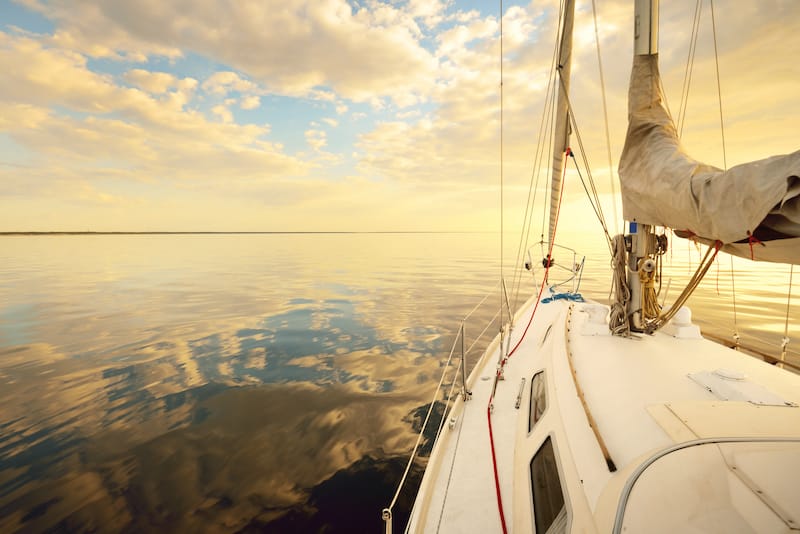While sailing lets you harness the wind’s power and bend it to propel your boat across the water, it has some inherent dangers.
Familiarizing yourself with these dangers and finding ways to avoid them is the first step toward achieving sailing safety. Here are eight tips for safe sailing.
Tips for Safe Sailing
Consider a vessel inspection
Maintaining a routine vessel safety inspection is an excellent way to ensure your boat’s safety, operational performance, and reliability.
During the safety check, the inspecting expert if the equipment is installed correctly, whether anything has become loose due to vibrations if there are any missing components, and ensure that the electrical connections don’t have corrosion.
It also involves testing the helm switches, load-testing the batteries, and checking the battery switches.
The lights and marine electronics are also checked. A sailing vessel inspection ensures that everything is running smoothly.
During the vessel inspection, you can get your sails checked to ensure they’re in pristine condition. If not, you can get a quality, custom-designed sail that suits your boat from field experts such as Far East Sails. This will ensure you have sufficient propulsive force to propel your vessel through the water.
Ensure everyone wears life jackets and belts
Life jackets and belts are vital sailing safety essentials. Before setting sail, ensure everyone aboard has fitted their vest correctly.
To ensure a life jacket is fitted properly, fit, adjust, and lift it from the shoulders to ascertain that it doesn’t move. If the jacket slides up, try fitting a smaller or tighter size. You can refer to the manufacturer’s guide before use.
A well-fitted life jacket keeps your nose and mouth high above the water. Ensure the personal floatation devices (PFDs) you use have the CE mark and the right equipment level for your craft.
Take a boating safety course
A boating safety course is crucial as it helps lessen property damage and personal injury linked with recreational boat usage and is vital for everyone on the water.
You’ll learn many boating safety aspects, including boat handling basics, understanding weather signs, navigation and engine maintenance, and safety and operational instruction foundation.
Basic boating courses offer you the knowledge you need to get a safety certification and boat license in most states. You’ll become a good, safer boater with a boat safety course. Boating safety education can also help save lives. Additionally, boat safety education is required in most states, so taking the course makes you compliant.
Check the weather beforehand
Warm, sunny weather is ideal for sailing. However, it’s difficult to predict when a storm might occur. Varying wind gusts and choppy water are an indication a storm is approaching.
Before leaving the dock, check the local weather and your destination forecast, where possible. Note that weather changes rapidly, even if it was okay before setting sail.
Upon seeing sudden wind shifts, lightning, or dark skies, get off the water immediately. Always carry a radio and keep looking out for bad weather when on the water.
Avoid drinking
Alcohol usage when sailing can be fatal. This could crowd your reflexes and judgment when in water, resulting in deadly accidents. Sailing under the influence is illegal and could count as a federal crime.
The physical effects of alcohol that can be detrimental to your sailing safety include cognitive ability deterioration and balance, vision, reaction time, and coordination impairment. Avoid taking any alcoholic drinks during and before sailing.
Always carry a boat safety kit
Emergencies are challenging to predict, so be ready for any situation. A boat safety kit should always be on board regardless of your boat’s size.
Your safety kit should include a flashlight, duct tape, first aid kit, bucket, whistle, ropes, mirror or any reflective object, garbage objects, and a fire extinguisher. Before leaving the shore, ensure your boat is well-stocked with food and water.
Drive at a safe speed and observe all boating safety and maritime rules
Poor lookout and high speed contribute to boating accidents. Ensure you understand the local waterway guidelines and laws and adhere to them.
Beware of traffic density, visibility, and navigational hazard proximity, such as rocks, floating objects, or shoals. Driving at safe sailing speeds is an excellent way to ensure safety.
Take action before a storm hits
The National Hurricane Center issues hurricane and storm warnings and forecasts. You can get this information from commercial and marine radios, newspapers, TV stations, or the National Hurricane Center website.
As a sailor, you should know the advisories issued and act before the storm hits. Adhering to these advisories is an excellent way to ensure sailing safety.
Endnote
Sailing can be fun and relaxing, but it comes with inherent dangers. Use these tips for safe sailing.

Megan is a travel blogger and writer with a background in digital marketing. Originally from Richmond, VA, she now splits her time between Frankfurt, Germany and Arctic Finland after also living in Norway, Armenia, and Kazakhstan. She has a passion for winter travel, as well as the Nordic countries, but you can also find her eating her way through Italy, perusing perfume stores in Paris, or taking road trips through the USA. Megan has written for or been featured by National Geographic, Forbes, Lonely Planet, the New York Times, and more. She co-authored Fodor’s Travel ‘Essential Norway’ and has visited 45 US states and 100+ countries.


